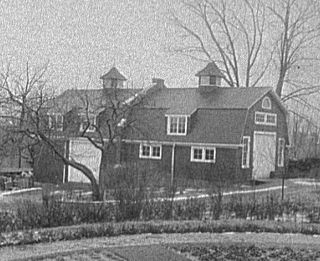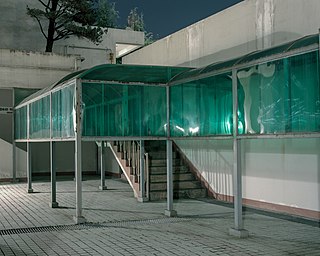ʻOhana is a Hawaiian term meaning "family" . The term is cognate with Māori kōhanga, meaning "nest". The root word ʻohā refers to the root or corm of the kalo, or taro plant, which Kanaka Maoli consider to be their cosmological ancestor.

An apartment, flat, or unit is a self-contained housing unit that occupies part of a building, generally on a single storey. There are many names for these overall buildings. The housing tenure of apartments also varies considerably, from large-scale public housing, to owner occupancy within what is legally a condominium, to tenants renting from a private landlord.

A housing estate is a group of homes and other buildings built together as a single development. The exact form may vary from country to country.

A single-family detached home, also called a single-detached dwelling,single-family residence (SFR) or separate house is a free-standing residential building. It is defined in opposition to a multi-family residential dwelling.

A garage apartment is an apartment built within the walls of, or on top of, the garage of a house. The garage may be attached or a separate building from the main house, but will have a separate entrance and may or may not have a communicating door to the main house. A garage apartment is one type of "accessory dwelling unit" or ADU, a term used by architects, urban planners and in zoning ordinances to identify apartments smaller than the main dwelling on one lot or parcel of land. Other examples of ADUs include granny flats, English basements, mother-in-law suites, and auxiliary units.

A duplex house plan has two living units attached to each other, either next to each other as townhouses, condominiums or above each other like apartments. By contrast, a building comprising two attached units on two distinct properties is typically considered semi-detached or twin homes but is also called a duplex in parts of the Northeastern United States, Western Canada, and Saudi Arabia.

Multifamily residential, also known as multidwelling unit (MDU)) is a classification of housing where multiple separate housing units for residential inhabitants are contained within one building or several buildings within one complex. Units can be next to each other (side-by-side units), or stacked on top of each other (top and bottom units). Common forms include apartment building and condominium, where typically the units are owned individually rather than leased from a single building owner. Many intentional communities incorporate multifamily residences, such as in cohousing projects.

John Wiley Bryant is an American politician who represented Texas's 5th congressional district in the 98th to 104th U.S. Congress.

Medium-density housing is a term used within urban planning and academic literature to refer to a category of residential development that falls between detached suburban housing and large multi-story buildings. There is no singular definition of medium-density housing as its precise definition tends to vary between jurisdiction. Scholars however, have found that medium density housing ranges from about 25 to 80 dwellings per hectare, although most commonly sits around 30 and 40 dwellings/hectare. Typical examples of medium-density housing include duplexes, triplexes, townhouses, row homes, detached homes with garden suites, and walk-up apartment buildings.

A carriage house, also called a remise or coach house, is a term used in North America to describe an outbuilding which was originally built to house horse-drawn carriages and their related tack. Carriage houses were often two stories, with related staff quarters above.
A secondary suite is a self contained dwelling, sometimes attached to the main dwelling, sometimes separate, which can be offered for rent to a third party by the owner/occupier. Some Canadian municipalities permit these while others do not, and rules vary as to what sort of dwellings are permitted to have secondary suites and what forms they may take.

A basement apartment is an apartment located below street level, underneath another structure—usually an apartment building, but possibly a house or a business. Cities in North America are beginning to recognize these units as a vital source of housing in urban areas and legally define them as an accessory dwelling unit or "ADU". Rent in basement apartments is usually much lower than it is in above-ground units, due to a number of deficiencies common to basement apartments. The apartments are usually cramped, and tend to be noisy, both from uninsulated building noises and from traffic on the adjacent street. They are also particularly vulnerable to burglary, especially those with windows at sidewalk level. In some instances, residential use of below-ground space is illegal, but is done anyway in order for the building owner to generate extra income.

A laneway house is a form of detached secondary suites in Canada built into pre-existing lots, usually in the backyard and opening onto the back lane. Most laneway houses are small. However, public concern has been raised in some communities about the impact that larger forms of this type of housing may have on privacy. Laneway houses are found in densely populated areas in Canadian cities, including Edmonton, Toronto, and Vancouver.

Missing middle housing refers to a lack of medium-density housing in the North American context. The term describes an urban planning phenomenon in Canada, the United States, Australia and more recent developments in industrialised and newly industrialising countries due to zoning regulations favoring social and racial separation and car-dependent suburban sprawl.
California Senate Bill 50 was a proposed California bill that would have preempted local government control of land zoning near public transit stations and jobs centers. The bill would have also required, at minimum, four-plex residential zoning statewide. The bill was the successor to a similar bill introduced by state senator Scott Wiener in January 2018 as Senate Bill 827 ; both would have applied to areas within one-half-mile (0.8 km) of frequent transit corridors, including rail stations and bus routes. The bills were sponsored by California YIMBY, a pro-housing lobbying group while they were opposed by local governments, anti-gentrification activists, and suburban homeowners. The bills were written in response to an ongoing housing affordability crisis in California's largest urban areas.

For many decades, the New York metropolitan area has suffered from an increasing shortage of housing, as housing supply has not met housing demand. As a result, New York City has the highest rents of any city in the United States.
Christopher Hawthorne is an American journalist and television director who served as the architecture critic for the Los Angeles Times from 2004 to 2018. In 2018, Los Angeles Mayor Eric Garcetti appointed him as the city's first Chief Design Officer.

Single-family zoning is a type of planning restriction applied to certain residential zones in the United States and Canada in order to restrict development to only allow single-family detached homes. It disallows townhomes, duplexes, and multifamily housing (apartments) from being built on any plot of land with this zoning designation.
In Australia, the dual occupancy concept was proposed by the Melbourne and Metropolitan Board of Works in 1981 to enable existing houses and housing lots to be subdivided into two to make more efficient use of existing facilities and urban infrastructure, to provide support links between the two households and to minimise external maintenance and gardening burdens. Nowadays, accessory dwelling units are increasingly being legitimized by state and local governments. These units can be a division of, addition to, or separate from the principal dwelling and are usually subject to minimum allotment sizes, site coverage, access and setback requirements. While dual properties are a fairly new concept in Australia, they have long been a common style of dwelling in countries such as Sweden, Japan and the United States.
2021 California Senate Bill 9 , titled the California Housing Opportunity and More Efficiency (HOME) Act, is a 2021 California state law which creates a legal process by which owners of certain single-family homes may either build two 800-square-foot homes or one duplex on their property, to result in a maximum of four housing units on a formerly single-family lot, and prohibits cities and counties from directly interfering with those who wish to build such homes. Drafted by State Senator Scott Wiener, it was signed into law by Governor Gavin Newsom in September 2021, and went into effect on January 1, 2022. The bill was crafted to reduce the cost of housing in California by increasing housing supply and density within California cities and overriding municipal and county zoning laws requiring single-family zoning. The law also expands the capacity for secondary suites.


















